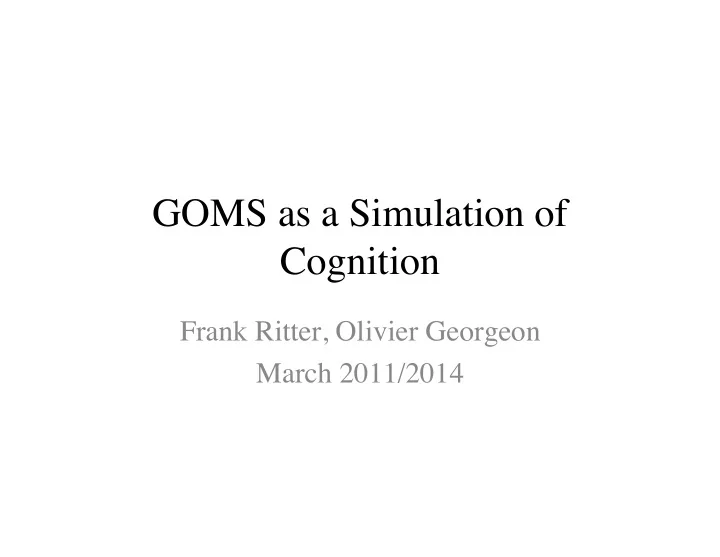

GOMS as a Simulation of Cognition Frank Ritter, Olivier Georgeon March 2011/2014
Cognitive architectures • "Brain emulator" – Simulates the computation we think the brain does (for doing a given task…). – Provides structures to store symbols – Provides instructions to manipulate symbols – Hypothesis: Goal-driven, Problem-solving, symbolic computation.
GOMS Architecture
Example: Check email • Procedure check_emails – Goal Login – Goal read_email • Goal memorize_sender's_name • Goal read_email_body – Goal reply_email(x) • Selection rule Select_appropriate_formulation(x) – Goal reply_email_friend » Operator Type (Hi <x>) » … – Goal reply_email_familly » Operator Type (Dear <x>) » … – Loop – Goal: Logout
Mental operations Visual buffer Long term memory Perceived_item: John (John, relation, friend) (Jack, relation, family) (email, name, John) Goals Selection rule Reply_email_friend If Perceived_item = X Reply_email_family And (X, relation, friend) memorize_sender's_name Then Process goal reply_email_friend
How To Use GOMS 1. Analyze hierarchical structure of a task a. coarse analysis focuses more on the cognitive structure of a task b. fine analysis focuses more on the structure imposed by the specific interface design 2. Analyze alternative methods 3. Assign operators to base level goals 4. Assign times to operators 5. Sum the operator times
Operator Times Press key on keyboard 280 ms Use mouse to point to object on screen 1,500 ms 300 ms Move hand to pointing device Move eyes to location on screen 230 ms 1,200 ms Retrieve item from memory Learn a single step in a procedure 25,000 ms Select among methods 1,200 ms More available in ABCS, GOMSL and CM&N
Summary • A method to describe tasks and how a user performs those tasks with a specific design – bridges task analysis with a specific interface design – error-free, goal-directed, and rational behavior • Views humans as information processors – small number of cognitive, perceptual, and motor operators characterize user behavior • To apply GOMS: – analyze task to identify user goals (hierarchical) – identify operators to achieve goals – sum operator times to predict performance
Recommend
More recommend